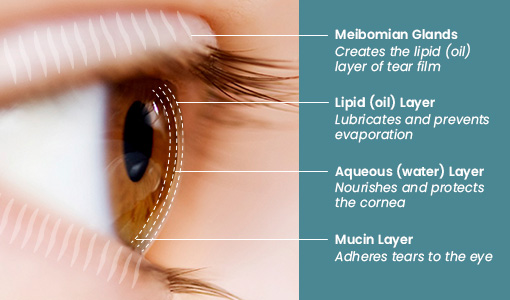About Dry Eye Disease
Dry Eye Disease (also called dry eye syndrome, dry eye, or dry eyes) is a chronic condition caused by a lack of adequate tear production. To those who have it, Dry Eye Disease is a nagging discomfort that won’t go away. In recent years significantly more has been learned about this common, yet frequently under-diagnosed, condition. It isn’t life-threatening, but it can be debilitating and has numerous causes and symptoms.
Dry Eye Disease Overview
1. Top (lipid) Layer: made of oil to seal the tear film and prevent evaporation.
2. Middle (aqueous or water) Layer: made of water to clean the ocular surface and resist against infection.
3. Bottom (mucin) Layer: made of mucous to help tear film adhere to the eye and provide tear film stability.

Types of Dry Eye Disease
The are two primary types of Dry Eye Disease. Patients most often suffer from one or the other, but it’s not uncommon for both to be present at the same time. At Dry Eye Institutes of America™, we use today’s most sophisticated technology to test, diagnose and treat for either or both of the following types:
Evaporative Dry Eye is an inflammation of the meibomian glands located in the eyelids. Meibomian glands make the lipid, or oily, part of your tears that slow evaporation to keep the tear film stable. Evaporative Dry Eye is now considered the most common type of Dry Eye Disease.
Aqueous Tear-Deficient Dry Eye happens when the lacrimal glands don’t produce enough of the watery (aqueous) layer of tears your eyes require. This is necessary to maintain a healthy eye surface.
Dry Eye Disease Today
We know that Dry Eye Disease has increased dramatically. Fortunately, we know more about how to diagnose and treat this condition than ever before. In short, Dry Eye Disease today is tied to the way we live and the world in which we live. The environment is changing. Our jobs, the way we communicate and find information has us constantly in front of computers and smartphones. We are taking more medications and our aging population is growing. All of these can contribute to Dry Eyes.
Yet our changing world has also brought forth innovation for more effective ways to prevent and treat Dry Eye symptoms. As Dry Eye treatment evolves, Dry Eye Institutes of America™ is uniquely committed to evolving with it to increase each patient’s quality of life.
